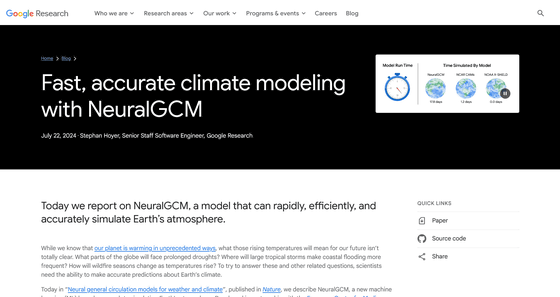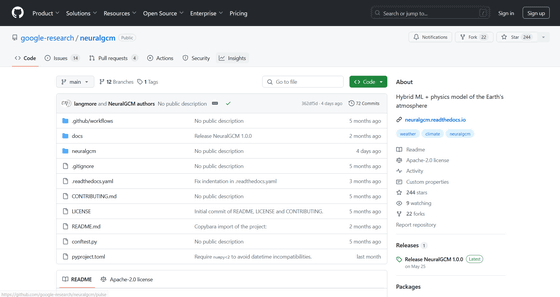Google Research releases 'NeuralGCM', a weather forecasting model that uses machine learning to perform 3,500 times faster and reduce costs by 1/100,000

Google Research, the research division of Google, has announced that it has developed a machine learning model, '
Fast, accurate climate modeling with NeuralGCM
https://research.google/blog/fast-accurate-climate-modeling-with-neuralgcm/

Google AI predicts long-term climate trends and weather — in minutes
https://www.nature.com/articles/d41586-024-02391-9
NeuralGCM is an innovative climate model developed by Google Research in collaboration with the European Centre for Medium-Range Weather Forecasts (ECMWF). The most distinctive feature of this model is that it combines traditional physics-based modeling techniques with the latest machine learning techniques.
Conventional climate models divide the Earth into large cubes and calculate meteorological phenomena within each cube based on physical laws. However, small-scale phenomena such as cloud formation and precipitation occur on a scale much smaller than the cube, making accurate simulation difficult. Therefore, these phenomena were approximated by simplified models called 'parameterization,' but this method had limitations in accuracy.
Google Research reports that NeuralGCM uses machine learning to calculate large-scale phenomena based on the laws of physics, but for small-scale phenomena, it learns from existing weather data. This method makes it possible to take into account complex interactions that could not be captured by conventional models.
Google Research has also reworked the algorithm for large-scale phenomena from scratch and implemented it in a machine learning framework called JAX , which allows the system's overall behavior to be optimized online, taking into account feedback from both small-scale and large-scale phenomena.

Google Research claims that NeuralGCM outperforms conventional models over a wide range of time scales, from short-term weather forecasts to long-term climate predictions. For example, in 2-15 day weather forecasts, NeuralGCM was 95% more accurate than ECMWF's state-of-the-art model. In addition, in 40-year temperature predictions from 1980 to 2020, the average error of conventional atmospheric models was 0.75°C, while NeuralGCM was able to reduce the average error to 0.25°C.

In terms of computational efficiency, NeuralGCM has also made great strides. For example, compared to

Google Research has made the model's source code and model weights available for non-commercial use on GitHub, allowing other researchers to add new factors to test hypotheses or improve the model's capabilities.
GitHub - google-research/neuralgcm: Hybrid ML + physics model of the Earth's atmosphere
https://github.com/google-research/neuralgcm

Related Posts:
in Software, Posted by log1i_yk







